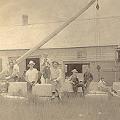 Stanstead’s local indigenous stone, and the mainstay of the local economy, is a variety of granite most often referred to as “Stanstead grey.” Stanstead grey has been quarried and worked in and around Beebe (which is now a part of Stanstead) for generations. But what exactly is this durable stone? To help us answer that question we enlisted the help of Robert Sheldon, who has been working with the stone for almost thirty years.
Stanstead’s local indigenous stone, and the mainstay of the local economy, is a variety of granite most often referred to as “Stanstead grey.” Stanstead grey has been quarried and worked in and around Beebe (which is now a part of Stanstead) for generations. But what exactly is this durable stone? To help us answer that question we enlisted the help of Robert Sheldon, who has been working with the stone for almost thirty years.
“First of all,” says Sheldon, “to be considered granite at all, a stone must contain at least 51 percent feldspar. Quartz is another component. Quartz is the second hardest stone after the diamond, and it’s quartz that makes granite so hard. So the more quartz in the granite, the harder it is.”
There are literally countless varieties of granite, it seems -- all of them formed millions of years ago when molten lava from deep in the earth cooled. When the lava reached the surface, it cooled, then hardened. “That’s where we see the outcroppings of granite,” Sheldon says. “The thin lines that we see in the granite are from a fine layer of ash settling on the hardening stone. The colour of the granite depends on what minerals were in the ground in that particular area.”
Essentially, granite is composed of feldspar, quartz and mica, but other minerals may be present in local variations of the stone, giving them their particular colouring, texture, and patterns. In the case of Stanstead grey, Sheldon explains, “what gives it its colour is silica, which is white, and mica, which is shiny. Sometimes there are black specks. That comes from iron deposits.”
Granite comes in all kinds of colours. Green granite gets its colour from copper; blue from zinc; red from potash; and so on. Grey granite, of which there are many varieties, is found along the entire length of the Appalachian mountain chain. That, says Sheldon, means there are “different shades of grey all the way from Quebec to Georgia. There are even different shades right around here, depending on the quarry.”
Grey is actually one of the softer granites. It is easier to work with than green, red or black granite. Stanstead grey is used mainly in construction and for monument bases. Because of the lines and other natural “faults” in the stone, it is seen as less desirable for the manufacture of monuments.